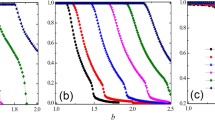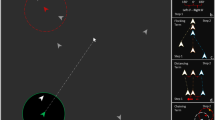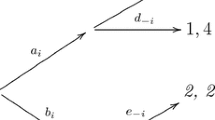Abstract
Collaboration has been widely studied throughout multiple disciplines, and it has been applied to a broad range of fields. In collaboration games, players’ strategies are the main influence on the final rewards or payoffs. In the field of biology, the phenomena of collaboration in coalition formation and in foraging have encouraged researchers to make great efforts in studying them. Quantitative models have been developed to include the biological complexities and behaviors of natural creatures and also to identify and predict the optimal strategies for them. Also, the models are applied in other fields, such as those (e.g., wireless sensor and robot networks) in the engineering realm. The purpose of this paper is to introduce and discuss those models, to gain inspiration from the modeling methods and analysis methods, to introduce the applications of the models in engineering, and to propose research directions in collaboration with presenting problems as examples that may be potentially solved with bio-inspired solutions. This paper surveys the quantitative models, including the assumptions in the models, modeling methods, and analysis methods as well as other studies that focus on the mechanism of the evolution of cooperation in nature systems.

Similar content being viewed by others
References
Abbasi A, Younis MF, Baroudi UA (2012) A least-movement topology repair algorithm for partitioned wireless sensor-actor networks. Int J Sens Netw 11(4):250–262
Balakrishnan M, Benhaddou D, Yuan X (2012) Preemptive emergency medium access for wireless sensor networks: performance under realistic network conditions. Int J Sens Netw 11(2):90–99
Barrett L, Henzi S (2001) The utility of grooming in baboon troops. In: Noë R, van Hooff JARAM, Hammerstein P (eds) Economics in nature: social dilemmas, mate choice and biological markets. Cambridge University Press, Cambridge
Beghdad R (2012) “Efficient coverage protocol without location information. Int J Sens Netw 11(4):263–273
Bercovitch F (1988) Coalitions, cooperation, and reproductive tactics among adult male baboons. Anim Behav 36:1198–1209
Bergstrom T (2009) Ethics, Evolution, and games Among Neighbors, The Selected Works of Ted C Bergstrom. Available at: http://works.bepress.com/ted_bergstrom/106
Bisnik N, Abouzeid A, Isler V (2006) Stochastic event capture using mobile sensors subject to a quality metric. In: Proceedings of the 12th annual international conference on Mobile computing and networking, pp 98–109
Boehm C (1999) Hierarchy in the forest: the evolution of egalitarian behavior. Harvard University Press, Cambridge (MA)
Bongard J (2009) Biologically inspired computing. IEEE Comput 42(4):95–98
Bulmer M (1994) Theoretical evolutionary ecology. Sinauer, Sunderland (MA)
Cai Z, Ji S, Li J (2012) Data caching-based query processing in multi-sink wireless sensor networks. Int J Sens Netw 11(2):109–125
Callegari C, Giordano S, Pagano M, Pepe T (2012) Detecting anomalies in backbone network traffic: a performance comparison among several change detection methods. Int J Sens Netw 11(4):205–214
Cao J, Jia X, Shu L (2012) Editorial. Int J Sens Netw 11(1):1–2
Caro T (1994) Cheetahs of the Serengeti Plains: group living in an asocial species, Wildlife Behaviour and Ecology. University of Chicago Press, Chicago
Caro T (2005) Antipredator defenses in birds and mammals. University of Chicago Press, Chicago
Carothers J, Jaksic F (1984) Time as a niche difference: the role of interference competition. Oikos 42:403–406
Charnov E (1976) Optimal foraging: the marginal value theorem. Theor Pop Biol 9:129–136
Chen B, Liu W (2012) A high computational power wireless sensor network for distributed structural health monitoring. Int J Sens Netw 11(3):137–147
Chew LW, Chia WC, Ang L, Seng KP (2012) Low-memory video compression architecture using strip-based processing for implementation in wireless multimedia sensor networks. International Journal of Sensor Networks 11(1):33–47
Chia WC, Chew LW, Ang L, Seng KP (2012) Low memory image stitching and compression for WMSN using strip-based processing. Int J Sens Netw 11(1):22–32
Christiansen F (1991) On conditions for evolutionary stability for a continuously varying character. Am Nat 138:37–50
Connor R, Whitehead H (2005) Alliances II. Rates of encounter during resource utilization: a general model of intrasexual alliance formation in fission-fusion societies, Anim Behav 69:127–132
Connor R, Smolker R, Richards A (1992) Dolphin alliances and coalitions. In: Harcourt AH, de Waal FBM (eds) Coalitions and alliances in humans and other animals. Oxford University Press, Oxford, pp 415–443
Connor R, Heithaus R, Barre L (1999) Superalliance of bottlenose dolphins. Nature 371:571–572
de Waa F, Harcourt A (1992) Coalitions and alliances: a history of ethological research. In: Harcourt AH, de Waal FBM (eds) Coalitions and alliances in humans and other animals. Oxford University Press, Oxford, pp 1–19
Dugatkin L (1998a) A model of coalition formation in animals. Proc of R Soc Lond B Biol Sci 265:2121–2125
Dugatkin L (1998b) Breaking up fights between others: a model of intervention behaviour. Proc R Soc Lond B Biol Sci 265:433–436
Dugatkin L (1998c) Game theory and cooperation. In: Dugatkin LA, Reeve HK (eds) Game theory and animal behavior. Oxford University Press, New York, pp 38–63
Engh A, Siebert E, Greenberg D, Holekamp K (2005) Patterns of alliance formation and postconflict aggression indicate spotted hyaenas recognise third-party relationships. Anim Behav 69:209–217
Enquist M, Leimar O (1983) Evolution of fighting behaviour: decision rules and assessment of relative strength. J Theor Biol 102:387–410
Eshel I (1983) Evolutionary and continuous stability. J Theor Biol 103:99–111
Gamm GU, Kostic M, Sippel M, Reindl LM (2012) Low-power sensor node with addressable wake-up on-demand capability. Int J Sens Netw 11(1):48–56
Gibbons R (1992) Game theory for applied economists. Princeton University Press, Princeton (NJ)
He J, Ji S, Yan M, Pan Y, Li Y (2012) Load-balanced CDS construction in wireless sensor networks via genetic algorithm. Int J Sens Netw 11(3):166–178
Hemelrijk C (1994) Support for being groomed in long-tailed macaques, Macaca fascicularis. Anim Behav 48:479–481
Houston A, McNamara J (1988) Fighting for food: a dynamic version of the hawk-dove game. Evol Ecol 2:51–64
Houston A, McNamara J (1999) Models of adaptive behaviour: an approach based on state. Cambridge University Press, Cambridge (UK)
Hsu Y, Wolf L (1999) The winner and loser effect: integrating multiple experiences. Anim Behav 57:903–910
Imhof L, Fudenberg D, Nowak M (2005) Evolutionary cycles of cooperation and defection. Proc Natl Acad Sci USA 102:10797–10800
Johnstone R, Dugatkin L (2000) Coalition formation in animals and the nature of winner and loser effects. Proc R Soc Lond B Biol Sci 267:17–21
Kempthorne O, Folks L (1971) Probability, statistics, and data analysis. The Iowa State University Press, Ames (IA)
Kotler B, Brown J, Subach A (1993) Mechanisms of species coexistence of optimal foragers: temporal partitioning by two species of sand dune gerbils. Oikos 67:548–556
Li D, Liu L, Du H (2012) An approximation algorithm for dominating nodes selection in multi-channel multi-radio wireless sensor networks. Int J Sens Netw 11(1):57–65
Liang X, Xiao Y (2010) Studying bio-inspired coalition formation of robots for detecting intrusions using game theory. IEEE Trans Syst Man Cybern Part B Cybern 40(3):683–693
Liang X, Xiao Y (2012a) Studying stochastic capturing moving intrusions by mobile sensors. Comput Math Appl. doi:10.1016/j.camwa.2012.05.016 (accepted)
Liang X, Xiao Y (2012b) Mobile sensor intrusion detection under any shape of curves. Math Comput Model (Elsevier). doi:10.1016/j.mcm.2012.01.005 (accepted)
Liu J, Xiao Y, Hao Q, Ghaboosi K (2009) Bio-inspired visual attention in agile sensing for target detection. Int J Sens Netw 5(2):98–111
Mangel M, Clark C (1988) Dynamic modeling in behavioral ecology. Princeton University Press, Princeton (NJ)
McDonald J (1981) North American bison. University of California Press, Berkeley (CA)
McNamara J, Webb J, Collins E, Szébely T, Houston A (1997) A general technique for computing evolutionarily stable strategies based on errors in decision-making. J Theor Biol 189:211–225
Medjiah S, Ahmed T, Hamid Asgari A (2012) Streaming multimedia over WMSNs: an online multipath routing protocol. Int J Sens Netw 11(1):10–21
Mesterton-Gibbons M (2001) An introduction to game-theoretic modeling. American Mathematical Society, USA
Mesterton-Gibbons M, Sherratt T (2007) Coalition formation: a game-theoretic analysis. Behav Ecol 18(2):277–286
Morrell L, Backwell P, Metcalfe N (2005) Fighting in fiddler crabs Uca mjoebergi: what determines duration? Anim Behav 70:653–662
Moya-Larano J, Wise D (2000) Survival regression analysis: a powerful tool for evaluating fighting and assessment. Anim Behav 60:307–313
Nandi A, Kundu S (2012) Optimal transmit power and packet size in wireless sensor networks in lognormal shadowed environment. Int J Sens Netw 11(2):81–89
Nash J (1951) Non-cooperative games. Ann Math 54:286–295
Nguyen DT, Nguyen NP, Thai MT, Helal A (2012) Optimal and distributed algorithms for coverage hole healing in hybrid sensor networks. Int J Sens Netw 11(4):228–240
Noe R (1990) A veto game played by baboons: a challenge to the use of the prisoner’s dilemma as a paradigm for reciprocity and cooperation. Anim Behav 39:78–90
Noe R (1992) Alliance formation among male baboons: shopping for profitable partners. In: Harcourt AH, de Waal FBM (eds) Coalitions and alliances in humans and other animals. Oxford University Press, Oxford, pp 285–321
Noe R (1994) A model of coalition formation among male baboons with fighting ability as the crucial parameter. Anim Behav 47:211–213
Noe R, Sluijter A (1995) Which adult male savanna baboons form coalitions? Int J Primatol 16:77–105
Nowak M (2006) Five rules for the evolution of cooperation. Science 314:1560–1563
Nowak M, Sigmund K (2004) Evolutionary dynamics of biological games. Science 303:793–799
Packer C (1977) Reciprocal altruism in Papio anubis. Nature 265:441–443
Packer C, Gilbert D, Pusey A, O’Brien S (1991) A molecular genetic analysis of kinship and co-operation in African lions. Nature 351:562–565
Pandit S, van Schaik C (2003) A model for leveling coalitions among primate males: toward a theory of egalitarianism. Behav Ecol Sociobiol 55:161–168
Pham C (2012) Coverage and activity management of wireless video sensor networks for surveillance applications. Int J Sens Netw 11(3):148–165
Ren Z, Younis M (2012) Exploiting architectural techniques for boosting base-station anonymity in wireless sensor networks. Int J Sens Netw 11(4):215–227
Richards S (2002a) Temporal partitioning and aggression among foragers: modeling the effects of stochasticity and individual state. Behav Ecol 13:427–438
Richards S (2002b) Optimal foraging among competitors and predators: a state-dependent model incorporating game theory. Israel Sci J 50:170–185
Richards S, de Roos A (2001) When is habitat assessment an advantage when foraging? Anim Behav 61:1101–1112
Rutte C, Taborsky M, Brinkhof M (2006) What sets the odds of winning and losing? Trends Ecol Evol 21:16–21
Ryer C, Olla B (1996) Social behavior of juvenile chum salmon, Oncorhynchus keta, under risk of predation: the influence of food distribution. Environ Biol Fishes 45:75–83
Schoener T (1974) The compression hypothesis and temporal resource partitioning. Proc Natl Acad Sci USA 71:4169–4172
Shan S, Wu W, Wang W, Du H, Gao X, Jiang A (2012) Constructing minimum interference connected dominating set for multi-channel multi-radio multi-hop wireless network. Int J Sens Netw 11(2):100–108
Silk J, Alberts S, Altmann J (2004) Patterns of coalition formation by adult female baboons in Amboseli, Kenya. Anim Behav 67:573–582
Silva R, Silva J, Caldeira JMLP, Rodrigues JJPC (2012) Mobile multimedia in wireless sensor networks. Int J Sens Netw 11(1):3–9
Smith J (1982) Evolution and the theory of game. Cambridge University Press, Cambridge
Smith J, Price G (1973) The logic of animal conflict. Nature 246:15–18
Thakur GS, Kumar U, Hsu W, Helmy A (2012) Gauging human mobility characteristics and its impact on mobile routing performance. Int J Sens Netw 11(3):179–191
Werner E, Gilliam J (1984) The ontogenetic niche and species interactions in size-structured populations. Annu Rev Ecol System 15:393–425
Whitehead H, Connor R (2005) Alliances I. How large should alliances be? Anim Behav 69:117–126
Whitehouse M (1997) The benefits of stealing from a predator: foraging rates, predation risk, and intraspecific aggression in the kleptoparasitic spider Argyrodes antipodiana. Behav Ecol 8:663–667
Xiao Y, Zhang Y (2011) Divide- and conquer-based surveillance framework using robots, sensor nodes, and RFID tags (Wiley). Wirel Commun Mobile Comput (WCMC) 11(7):964–979. doi:10.1002/wcm.863
Xiao Y, Zhang Y, Liang X (2011) Primate-inspired communication methods for mobile and static sensors and rfid tags. ACM Trans Auton Adapt Syst 6(4):26:1–26:37
Xu H, Huang L, Zhang Z, Liu G, Zhang Y (2012) Cooperative relay assignment for static energy-constrained networks. International Journal of Sensor Networks 11(3):192–203
Y. Xiao and Y. Zhang, A critical line based boundary surveillance strategy in wireless sensor networks. Telecommun Syst J (Springer), Special issue on: Challenges in next-generation and resource-constrained networks, accepted and to appear. doi: 10.1007/s11235-011-9453-0
Zabel C, Glickman S, Frank L, Woodmansee K, Keppel G (1992) Coalition formation in a colony of prepubertal spotted hyaenas. In: Harcourt AH, de Waal FBM (eds) Coalitions and alliances in humans and other animals. Oxford University Press, Oxford, pp 113–135
Zeghilet H, Maimour M, Badache N, Lepage F (2012) On the use of passive clustering in wireless video sensor networksr. Int J Sens Netw 11(2):67–80
Zhang Y, Xiao Y, Bales KL (2009) Primate social systems, scent-marking, and their applications in mobile and static sensor networks. Int J Sens Netw 5(4):210–222
Zhang X, Xie L, Shen X (2012) Energy-efficient transmission and bit allocation schemes in wireless sensor networks. Int J Sens Netw 11(4):241–249
Zheng J, Huang Y, Xiao Y (2012a) The Effect of Leaders on the Consistency of Group Behavior. Int J Sens Netw 11(2):126–135
Zheng J, Huang Y, Wang Y, Xiao Y (2012b) The effects of wireless communication failures on group behavior of mobile sensors (Wiley). Wirel Commun Mobile Comput (WCMC). doi:10.1002/wcm.2189 (accepted)
Ziv Y, Abramsky Z, Kotler B, Subach A (1993) Interference competition and temporal and habitat partitioning in two gerbil species. Oikos 66:237–246
Acknowledgments
This work is supported in part by The U.S. National Science Foundation (NSF), under grants: CNS-0716211, CCF-0829827, CNS-0737325, and CNS-1059265. This work is supported in part by the National Fundamental Research 973 Program of China under 2010CB334705.
Author information
Authors and Affiliations
Corresponding author
Rights and permissions
About this article
Cite this article
Liang, X., Xiao, Y. A survey of biological collaboration models. J Ambient Intell Human Comput 5, 551–563 (2014). https://doi.org/10.1007/s12652-012-0164-5
Received:
Accepted:
Published:
Issue Date:
DOI: https://doi.org/10.1007/s12652-012-0164-5




